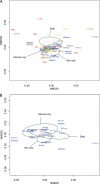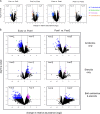Airway microbiome dynamics in exacerbations of chronic obstructive pulmonary disease
- PMID: 24850358
- PMCID: PMC4136157
- DOI: 10.1128/JCM.00035-14
Airway microbiome dynamics in exacerbations of chronic obstructive pulmonary disease
Abstract
Specific bacterial species are implicated in the pathogenesis of exacerbations of chronic obstructive pulmonary disease (COPD). However, recent studies of clinically stable COPD patients have demonstrated a greater diversity of airway microbiota, whose role in acute exacerbations is unclear. In this study, temporal changes in the airway microbiome before, at the onset of, and after an acute exacerbation were examined in 60 sputum samples collected from subjects enrolled in a longitudinal study of bacterial infection in COPD. Microbiome composition and predicted functions were examined using 16S rRNA-based culture-independent profiling methods. Shifts in the abundance (≥ 2-fold, P < 0.05) of many taxa at exacerbation and after treatment were observed. Microbiota members that were increased at exacerbation were primarily of the Proteobacteria phylum, including nontypical COPD pathogens. Changes in the bacterial composition after treatment for an exacerbation differed significantly among the therapy regimens clinically prescribed (antibiotics only, oral corticosteroids only, or both). Treatment with antibiotics alone primarily decreased the abundance of Proteobacteria, with the prolonged suppression of some microbiota members being observed. In contrast, treatment with corticosteroids alone led to enrichment for Proteobacteria and members of other phyla. Predicted metagenomes of particular microbiota members involved in these compositional shifts indicated exacerbation-associated loss of functions involved in the synthesis of antimicrobial and anti-inflammatory products, alongside enrichment in functions related to pathogen-elicited inflammation. These trends reversed upon clinical recovery. Further larger studies will be necessary to determine whether specific compositional or functional changes detected in the airway microbiome could be useful indicators of exacerbation development or outcome.
Copyright © 2014, American Society for Microbiology. All Rights Reserved.
Figures






References
Publication types
MeSH terms
Substances
Grants and funding
LinkOut - more resources
Full Text Sources
Other Literature Sources
Medical

